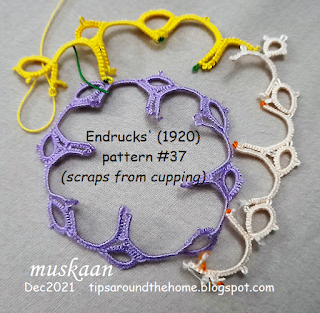Pin It now!
Sounds
crazy oxymoronic? Read on …
We
have just thanked our very first volunteer, Mariantonietta here https://ninettacaruso.blogspot.com/2021/11/willing-volunteer.html and
now we take equal pleasure in thanking Julie, our last ‘voluntary non-volunteer’.
In
Nov 2020 volunteers had chosen pattern(s) from Endrucks’ book to tat and
present in modern forma,. Over time 3 of our volunteers had to step back for
personal reasons and mid-2021 we opened up their selections for pickings. They
were pounced upon and selection was closed.
Direct
link to pdf (updated version) - https://drive.google.com/file/d/1SmqcWxtPAlvveValWZmTlq-tHucSa6wr/view
It
just so happened that Julie Santos Villegas was in neither of these volunteer lists.
Yet, she could not contain her enthusiasm and almost overnight she tatted
pattern n.7 and shared her sampler which was slightly modified from the
original. When asked if she would like to present her work in a proper pdf with
pattern, she readily and whole-heartedly agreed, roping in her son to diagram
it too!
Does
‘willing non-volunteer’ makes sense now? Turned out Julie was the last person to
make it to the community project since all patterns were finally chosen at the time. Few
changes occurred subsequently but the story will continue in respective posts. Mind
you, we still have to introduce and thank many more contributors since we are
not following any chronological order. And new ones are cropping up in our FB
Group, too!
Throughout
our collaboration and engagement, Julie has been enthusiastic, responsive and receptive in
equal measure - a true team player. It
has been a pleasure to get to know her. Her son, Robbie, has been instrumental
in drawing the diagram(s).
Julie
had started her first sampler from the lower central ring (starred in above pic) instead of with a
chain as in the original and we uploaded the pdf in July. Since then she
altered the start to the side ring and also tatted a 2-colour sampler and
included a written pattern so that more tatters could benefit. Robbie had to
alter the diagram. They make a good mother-son team and we thank them both!
She
graciously shared her tatting journey …..
“I
learned tatting in high school. I remember having a good teacher who constantly
reminded me of my thread tension. I enjoyed the craft so much that I tatted a
green edging for a blouse collar. It was just rings and bare thread. College
and adult life followed and tatting was completely forgotten until I retired in
2008. Thinking of what to do next to occupy my retirement, I looked back to
what I enjoyed most doing when I was younger. Thankfully the Internet was
already dominating our lives. I googled “tatting” and the rest is history.
Through you tube I learned from generous tatting masters how to make chains,
cluny, split rings, onion rings and many more. There is a lot more to learn but
I am not complaining. I think tatting and I will grow old together.”
Her
last sentence is quite philosophical and a good way to ‘grow’…
Ninetta
joins me in thanking Julie for her willing contribution, team spirit and
enthusiasm.
**********************
Endrucks 1920 Project is a community project, we
welcome every one of you to join in and enjoy the modern-style pdfs that have
been uploaded! Please let us know where we can find your renditions and
derivative tatting!
We created the hashtag #Endrucks1920Project, so please use
it for your pics to show up in a search.
*** NEW! *** We have a
Facebook Group (please read the group’s description and rules before asking to
join) – “Endrucks 1920 Project”: https://www.facebook.com/groups/1235560633606162
We all enjoy sharing and experimenting and the group is
waiting for you! All info and links (original
and modern) are in the Endrucks 1920 Project Document, here: https://docs.google.com/document/d/17LEVftXweztBIOWh4sL4BB7bX65ssoOsOn4oXIgCepY/view
Remember there are many more modernised patterns, derived
and extracted patterns/ideas, already listed in the project document, with more
still to come! So, do visit and scroll through.
*********************
With love and gratitude,
muskaan & Ninetta




















































